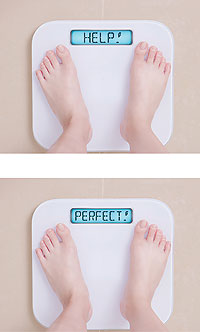|
|
HEALTHY HAPPENINGS - August 2023
|
The Latest Weight Loss Craze
by Ray Andrew, MD
|
 These days, you can hardly talk about weight loss without the name “semaglutide” (or one of its trade names) popping up. Semaglutide is a peptide in the class known as GLP-1 agonists, an increasingly-crowded field of diabetes medicines that has actually been around for many years now. The difference between semaglutide and most of its counterparts is that it tends to lead to significant weight loss. For this reason, more people will likely be prescribed semaglutide for weight loss than for diabetes. Americans are so desperate to lose weight—we are more overweight than ever, after all—that vast numbers are paying out of their own pockets for the peptide when insurance companies are refusing to cover it. As far as insurance companies are concerned, diabetes is a “real” disease whereas overweight and obesity are just problems of willpower and laziness. These days, you can hardly talk about weight loss without the name “semaglutide” (or one of its trade names) popping up. Semaglutide is a peptide in the class known as GLP-1 agonists, an increasingly-crowded field of diabetes medicines that has actually been around for many years now. The difference between semaglutide and most of its counterparts is that it tends to lead to significant weight loss. For this reason, more people will likely be prescribed semaglutide for weight loss than for diabetes. Americans are so desperate to lose weight—we are more overweight than ever, after all—that vast numbers are paying out of their own pockets for the peptide when insurance companies are refusing to cover it. As far as insurance companies are concerned, diabetes is a “real” disease whereas overweight and obesity are just problems of willpower and laziness.
This mentality is not surprising considering the mainstream medical model itself has hardly wavered over the last 50 years. Doctors are taught that all one has to do is eat fewer calories than one uses, i.e. eat less and exercise more. Few medical myths have been more damaging to human health in the last hundred years.
This is not to say that there is no rule for decreasing calories and increasing physical activity. Far from it. It is simply to say that weight gain and weight loss resistance are far more complex than such a simple mantra. Any woman who has gone through menopause, for example, knows that overnight she started gaining weight without having increased her caloric intake one bit.
Obviously, anyone who is serious about losing weight will first look at his or her diet and consider whether changes need to be made. Minimizing dietary inflammation can have dramatic benefits. This of course means eliminating refined sugar, which tastes great and is highly addictive but has no role in human health other than to ruin it, increasing pain and just about every chronic disease you can name. When eliminating sugar proves inadequate, you can gain additional benefit by reducing carbohydrates overall and eliminating processed foods, dairy, and grains.

Exercise plays an important role in maintenance of muscle mass, bone strength, balance, mood, and healthy weight. Unfortunately, the modern food industry has concentrated nutrient-poor calories so much that there aren’t enough hours in the day to burn through exercise the calories many of us eat after visiting the convenience store or drive-through. Consequently, we need to think of exercise as an essential component of a healthy life, not as a weight loss strategy.
If you already follow a healthy diet and regular exercise program, semaglutide can be a game-changer. In a study lasting 68 weeks, people who took one of the drug company formulations of this peptide lost an average of 31 pounds. Compared to placebo, people taking semaglutide have less appetite, less desire to overeat, reduced sugar cravings, and reduced pain. Their blood sugars drop significantly and insulin sensitivity improves. They have a lower risk of heart disease, stroke, kidney disease, and even seizures.
As you can see, semaglutide could be the tool that helps you finally bring your weight under control when everything else has failed you. So why not take the plunge? Well, there are two things you need to take into consideration. First, some people experience side effects, such as nausea, diarrhea, constipation, or abdominal pain. This is one reason why the “one-size-fits-all” pharmaceutical company approach doesn’t work for some people: you can’t adjust the dose to start low and work your way up gradually, as tolerated.
Secondly, if you’re thinking seriously about starting treatment with semaglutide, you need to know that it is just a tool, not the magic injection that’s going to permanently melt all the fat away. Not everyone who takes it loses weight. Moreover, a recent study revealed that when you stop taking it, you risk gaining back two-thirds of the weight you lost.
How could this happen? Actually, there are lots of reasons, but they all boil down to one thing: If you haven’t identified and solved the problems that caused the weight gain in the first place, it’s going to continue. Or, you can take semaglutide for months and find you are not losing any weight at all.

Look at it this way: Suppose you get crazy one day and decide to row up the Colorado River. If the river is flowing at 3 miles per hour, and you can only row at 3 miles per hour, you aren’t going to go anywhere. Suppose instead that you attach a motor to your boat and can go 6 miles per hour. Now you’re really going somewhere. Unfortunately, as soon as you cut the motor, you’re headed back down the river.
If you want to head up the river and stay there without leaving the motor on forever, you’ve got to either stop the flow of water or anchor yourself to the bottom or something on the shore. In terms of achieving and maintaining a healthy weight, this means looking at hormone imbalances, hidden infections, and toxicities.
Take the case of 41-year-old Sandra, for example. Last year, she came to me desperate to lose weight and requesting semaglutide. During her first consultation, we talked not just about her weight, but also about a few other aspects of her health that were not optimal. She left the office with her prescription for semaglutide and a plan to fix the problems that were affecting her overall health. Three months after her first visit, she had lost 32 pounds. “Wow,” I exclaimed, “that semaglutide is pretty powerful stuff! You lost in three months what the study participants took 16 months to lose!” “I decided not to take it,” she then admitted. “I was doing so well with the other things you told me to do that I realized I didn’t need the peptide.” Several months later, she had reached a total drop of 46 pounds and still hasn’t gone on a weight loss diet or taken anything specifically for weight loss.
Granted, there is no reason Sandra could not have used semaglutide at the same time as undertaking the other measures necessary to optimize her health. She just didn’t feel it was necessary. If you are feeling the need to shed some weight and are ready to get your health back, call Prestige Wellness Institute at (435) 210-0184. Whether you do it with or without the assistance of semaglutide, you can get back to the state of health you deserve.
And be sure to mention you read about it in Moab Happenings!
|
Don’t Forget Your Back-to-school Immunizations!
Moab Regional Hospital
|
As a parent, you want what's best for your children. You use safety precautions such as car seats or baby gates that keep them safe. Sometimes parents forget that ensuring their child receives all childhood vaccinations is crucial to keeping them safe. With school approaching, it's time to consider your child's immunizations and ensure they are on schedule.
What is the difference between vaccination and immunization? Vaccines protect children from deadly diseases and practically eliminate dangerous diseases that used to spread quickly and are part of the germ that causes the disease in question. Getting immunized is the process of being exposed to a disease in vaccine form, which helps the immune system build antibodies that protect the person from contracting the disease, and then becoming immune to the disease after vaccination. Often the words are used interchangeably.
A vaccine schedule lists common vaccines that should be administered to children at certain ages. The Utah Immunization Rule for Students mandates all pre-kindergarten, kindergarten, and 7th-grade students to provide proof of immunization, an exemption, or proof of immunity against a disease for which the vaccination is required.
Take a quick look at some facts about immunizations:
1. Immunizations can save your child's life. Because of advances in medical science, your child can be protected against more diseases than ever before. Some diseases that once injured or killed thousands of children have been eliminated, and others are close to extinction – primarily due to safe and effective vaccines.
2. Vaccination is safe and effective. Vaccines are only given to children after a long and careful review by scientists, doctors, and healthcare professionals. Vaccines can involve discomfort and may cause pain, redness, or tenderness at the injection site. However, this is minimal compared to the pain, discomfort, and trauma of the diseases these vaccines prevent. Serious side effects following vaccination, such as severe allergic reactions, are rare. The disease-prevention benefits of vaccines outweigh the possible side effects for almost all children.
3. Immunization protects others and future generations. Vaccines have reduced and, in some cases, eliminated many diseases that killed or severely disabled people just a few generations ago. For example, the smallpox vaccination eradicated that disease worldwide. Your children no longer need smallpox shots because the disease no longer exists. By vaccinating children against rubella (German measles), the risk that pregnant women will pass this virus on to their fetus or newborn has been dramatically decreased, and congenital disabilities associated with that virus are no longer seen in the United States. If we continue vaccinating, parents in the future can trust that some diseases of today will no longer be around to harm their children in the future.
The Family Medicine Clinic at Moab Regional Hospital offers walk-in immunizations Mondays – Thursdays 9am-4pm and Fridays from 9am-3pm; no appointment is necessary! Call 435-719-5500 for any questions.
Moab Regional Hospital is a 17-bed not-for-profit Critical Access Hospital and Level IV Trauma Center located in Moab, Utah, and is the leader in healthcare in southeastern Utah. Our mission is to put our patients first, deliver quality, cost-effective healthcare, and promote wellness to all we serve.

Free Community Lunch
Thursdays from 11:30am to 1:00pm at the St. Francis Episcopal Church (250 Kane Creek Boulevard, Moab). Free lunches for all who come by. Homemade soups (always several choices) or sandwiches, bread (chips with sandwiches), dessert, coffee and water. Call St. Francis Episcopal Church at 435 259-5831 for information.
Free Community Food Pantry
Fridays from 4-6pm at the St. Francis Episcopal Church (250 Kane Creek Boulevard, Moab) No ID, no name, no address, no personal information needed. We always have canned goods, bagged goods, meat. We often have bread, fresh produce, milk, cheese, fruit juice, eggs. Also personal toiletries, cleaning supplies, diapers, dog food. Feel free to pick up for someone who can't get out, or someone who is working. Call St. Francis Episcopal Church at 435 259-5831 for information.
Moab Valley Multicultural Center Food Pantry
Clients may access the Food Pantry once every two weeks. Schedule:
Mon Wed Thu: 9am-12pm, 1-5pm
Tue: 9am-12pm, 2:30-5pm
Fri: 9am-12pm
LUNCH at the Grand Center,
182 N. 500 W. Noon on Mon, Tues, Wed & Fri under 60: $6.00 over 60: $2.50 suggested donation
Moab Community Health Talks - Our Village Community Center hosts Dr. Don Leathers, naturopathic physician, and Sarah Cook, massage therapist health coach & lay homeopath in an informal round table discussion meant for community members to have their questions answered in a supportive space. Second Wednesday of each month. 1-2pm at Our Village Community Center, 721 N 500 W, Moab. Suggested donation of $5-$20. Info: ourvillage.org, phoenixrisingmoab.com, sarahcookmassage.com or 435-260-0294 or 435-259-8123
Moab Community Yoga
Tuesdays 6:30-7:30pm at the Moab Arts and Recreation Center (MARC) in the dance room. 111 E 100 N
Gyrokinesis® Class w/ Anne Howe
The Gyrokinesis® Method is a movement method that addresses the entire body, opening energy pathways, stimulating the nervous system, increasing range of motion and creating functional strength through rhythmic, flowing movement sequences. It is an original and unique method that coordinates movement, breath and mental focus. Thursdays 5:30-6:30pm. Sundari Yoga & Wellness Studio 1105 S US-191 #3 www.sundariyogamoab.com
Sheng Zhen Meditation - Thursdays 5:30-7pm at Moab Arts and Recreation Center. Other classes available and info at shengzhenmoab.com/
Community Reiki (Alternating Tuesdays, 9am & 3pm)
Join Crystal at Mindful Movement Moab, 76 S Main St Suite 15, for a free 30 minute community Reiki Session. Must be a local resident for the session. Sign up online at www.mindfulmovementmoab.com
Yoga in the Park (Wednesdays, Swanny Park, 5pm)
Join Breann with Wellness Collective for a 60 minute yoga session brought to the community by a partnership with USARA. Mats are provided and the class is open to everyone in the community. Yoga is free. At Swanny Park. Sign up for class online at www.wellnesscollectivemoab.com
Yoga in the Park (Thursdays, Swanny Park, 8am)
Join Crystal with Wellness Collective for a 45 minute yoga session brought to the community by a partnership with USARA. Mats are provided and the class is open to everyone in the community. Yoga is free and you can sign up for class online at www.wellnesscollectivemoab.com
Virtual Mindfulness Class (Thursdays, 6pm)
Join the facilitators with Wellness Collective for a 30 minute mindfulness session brought to the community by a partnership with USARA. Class is free and you can sign up online to receive the zoom link.
www.wellnesscollectivemoab.com
Virtual Trauma Sensitive Yoga (Mondays, 6pm) Trauma Sensitive Yoga focuses on the use of yoga movements as an opportunity to practice making choices with our bodies and to possibly notice what we feel in our bodies. Class is free and you can sign up online to receive the zoom link. www.wellnesscollectivemoab.com
|
|
|
|
|
|
|
|
|
© 2002-2024 Moab Happenings. All rights
reserved.
Reproduction of information contained in this site is
expressly prohibited.
|
|